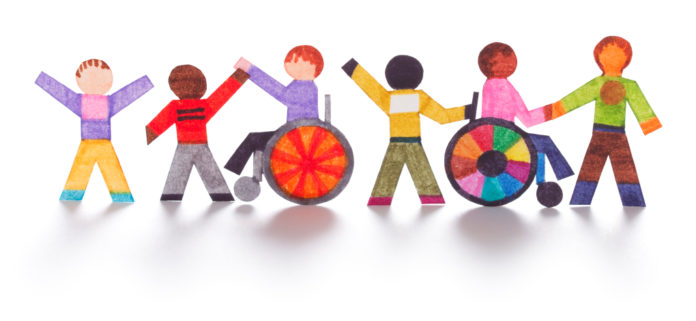A dear friend and a fellow parent of a daughter with Down syndrome always refers to ‘Inclusion’ as a ‘double-edged sword,’ explaining how in absence of good inclusion framework, if children with special needs are placed in mainstream schools; not only their possible learning gets restricted, but their confidence and self-belief can take a toll and this often results in behavioural issues.
His statement is not entirely incorrect! Demanding and enforcing inclusion can be exhausting for parents and if schools are endorsing it only for the sake of the law and are happy sending children with special needs into ‘pull outs’ and ‘special-ed rooms,’ without actually believing into the concept of ‘Inclusion, it becomes a multi-level issue for parents, teachers as well as for the children. The IEP meetings become the battlegrounds and a place for anxiety exchange. But I also believe that just because inclusion is not working the way it should, parents should also not ‘Give up’ wanting it! Our children benefit greatly from social inclusion, a need for routine, age-appropriate expectations, and peer groups! While most schools believe they are doing the best they can, the reality is completely different.
Now the real question arises! Are only the schools at fault here? And while they genuinely believe they are doing the best for the children with special needs (including sending them into separate classrooms) Can they really do any better in the absence of resources or adequate training? My answer is a BIG YES!
Torrie Dunlap, C.E.O, ‘Kids included together,’ explains it beautifully “We have moved from hiding and institutionalizing children to a world where kids with disabilities are “special” and receive special services in special settings with special caregivers, and they- and their families- are disenfranchised from the community at large and have become their own separate community. I believe that ‘special’ has become a euphemism for ‘separate.’ When we create a separate, ‘special’ places for children where their ‘special needs’ can be met, we are teaching them that their place is over there, with people like them and not in the full community. When young, impressionable children are taught that their needs are too great, that they are too different and that they don’t fit our very narrow definition of “normal” this has a lifelong effect on their ability to contribute positively to society.

But schools don’t believe it! They have reasons and perfectly sound reasons that they have formed over the years of ill-intentioned integration and, less than ideal inclusion about how segregation work for the advantage of children with intellectual delays and, how they don’t learn in group settings and that their learning is optimum when they are taught individually or in very small groups. The best/worst part is that the parents, too get convinced thinking the professionals and so called experts know best. And, who are we kidding! Most of the times the parents do not even have a say in these matters!
If you, as a parent, educator or a professional are convinced with what most experts believe; that true inclusion is ‘TOTAL INCLUSION’ with the least restrictive environment, then there is a dire need to reach out to schools to help them form a better model for inclusion.
I love the definition of ‘Inclusion’ by ‘Norman Kunc ‘
“When inclusive education is fully embraced, we abandon the idea that children have to become ‘normal’ in order to contribute to the world. …We begin to look beyond typical ways of becoming valued members of the community, and in doing so, begin to realize the achievable goal of providing all children with an authentic sense of belonging.”
He further states that “Inclusion is not only a philosophy, but it is also a schedule where no student engages in ‘pull out’ or alternative activities to the extent that disruptions in peer relationships occur.”
You may also like : What Can Schools Do Differently To Support Children With Special Needs?
This might look like out of a ‘Utopian school,’ but the truth is that schools all over the world are increasingly accepting and implementing this idea of inclusion and, it is helping not only the children with special needs but the typical children equally! And it is not heavy on resources as generally believed (We have research to believe!)
In order for us to change the idea of ‘INCLUSION’, it is imperative for the parents to also understand the possible perceived problems or challenges that a school faces. Because only then we can help them with the solutions for the same. Here are the three most talked about concerns that schools summons the parent for. Let’s talk about these to know how best we can help it alter its perceptions!
1. Your child is not performing at the grade level:
I know, I totally get it! If he was able to perform at the grade level, we would not have been here discussing inclusion, so I totally get it. The trouble is not with the child not performing at the grade level, the problem is the school people expecting him to be able to perform exactly like her ‘neuro-typical’ peers. While it is good to have ‘great expectations’ but expecting our kids to do the same algebra question that everybody else is doing, in the same time, is NOT REAL! Modification should be the key. Our children, with support CAN, achieve the ‘minimum learning outcome’ required in a grade level. So if the modifications are done accordingly and the end of the year ‘Goals’ based on child’s previous performance are defined well in advance, the parents and teachers can sleep peacefully.
Additionally the information about the alternative mediums and modified assessment options should be discussed at length. For instance, National open school India offers a scribe for its language papers. Also, in some schools, the assessment for the same can be done orally too. KNOWLEDGE IS THE KEY!

2. Your child needs a ‘shadow teacher’ or a ‘personal-aid’:
In a lot of schools, a personal aid is required to be sent along with the child every single day- from day one! Seems like the schools believe so strongly into the non-competence of the child that they know well in advance about our children with special needs not being able to learn, thrive or even sustain themselves without somebody actively taking care of them.
Asking for a shadow teacher has become like a ‘No question asked demand’ by the schools that a parent has to comply without having a say. And why not? This solves many problems for the school; one, they never have to worry about the safety of the child, two they don’t have to teach or spend much time on him since that becomes the primary responsibility of the personal aid, and the last is they don’t even have to spend any money on this additional resource as in most of the developing countries like India, it is the parents obligation or duty to pay the personal aid since it is their fault that they have a child with special needs.
My problem with this system is about highlighting the child’s inadequacy by implying through an adult supervision that he is not independent enough and will never be, because in no cases, the weaning ever happens. Though a lot of times with a personal aid, children do get help academically but do not get accepted socially in the peer group. They also get overly dependent on the instructions of the aid. Another important factor is if you can’t afford the aid, you can’t send the child to school. Period!

3. Your child learns best in a small group:
Your child learns best in a small group and though he would be included in the morning assembly, sports and other extra-curricular activities, the rest of his classes would only happen in a separate class. This sounds like a ‘special school’ set up within the mainstream school. Based on the premises that it is being done for the betterment of your child and the school wants only the best for the child. The truth is, we are not able to make it work and this segregation works for everyone! ‘Julie Causton’, the Inclusion expert, puts it perfectly here:
“Segregated classrooms for students with disabilities are actually the most distracting educational environments. These classrooms house many students with different kinds of disabilities and many professionals in the same space, which means that it is naturally a stigmatizing environment, and students often respond to that environment by behaving. The nature of students’ disabilities in one room also can become overwhelming.
A much less distracting educational environment is having your child surrounded by their same- age peers, who have age appropriate language and behaviour. This allows for excellent communication, language and behavioural models. Separate but equal is inherently unequal based on difference, and the same is true for students with disabilities

About the overdependence of special-eds in the schools, she further writes,
“Schools must transcend the myth that special educators have ‘magic dust’ that enables them to work effectively with students with disabilities,” –
INCLUSION is not putting all the children with special needs in one class with one educator, it is also not having one adult take care of one child at all times, it is also not creating separate spaces within the classroom; Inclusion is a belief, a process, a practice, which can only be established if the school can start to believe in it wholeheartedly and not just because it is mandated by the ‘Law’. Sure there may be challenges and roadblocks, but we do have successful models of it being implemented in Italy, Finland and other places. Schools can invest in materials, support strategies, training, and modified curriculum to help children with special needs.
Would love to end this by this beautiful quote from unknown
“Inclusion is more than a set of strategies or practices; It is an educational orientation that embraces differences and values the uniqueness that each learner brings to the classroom.”
Hope to see the real ‘INCLUSION’ and hope to see a better world where the parents don’t have to fight to get their children ‘INCLUDED’ Amen!
Credit






